诺贝尔奖与遗传学
- 格式:ppt
- 大小:1.49 MB
- 文档页数:67
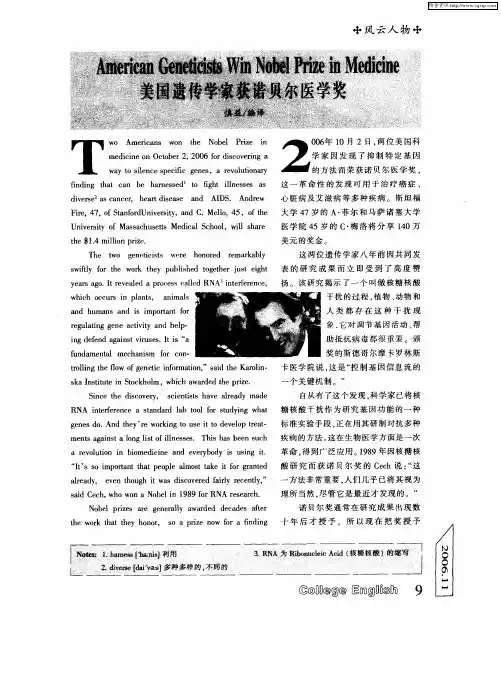
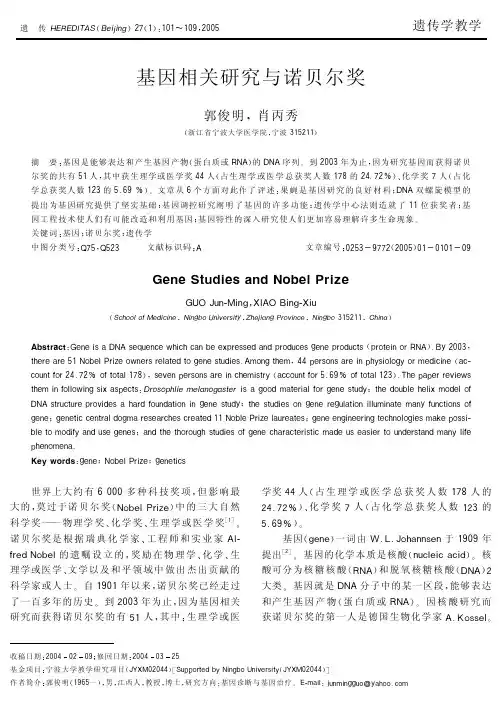
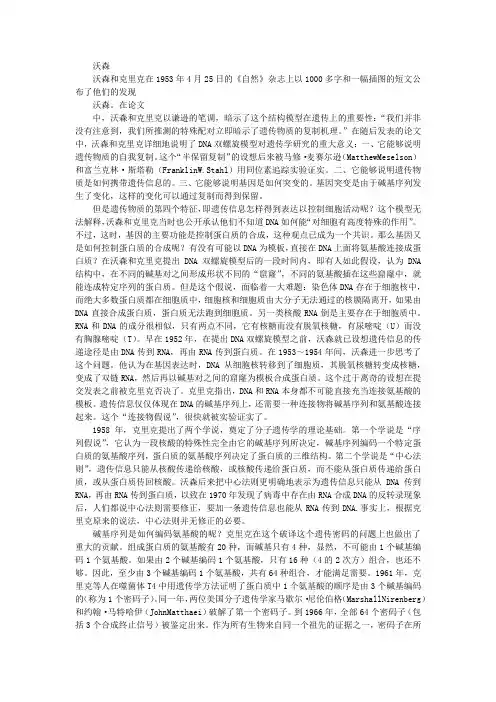
沃森沃森和克里克在1953年4月25日的《自然》杂志上以1000多字和一幅插图的短文公布了他们的发现沃森。
在论文中,沃森和克里克以谦逊的笔调,暗示了这个结构模型在遗传上的重要性:“我们并非没有注意到,我们所推测的特殊配对立即暗示了遗传物质的复制机理。
”在随后发表的论文中,沃森和克里克详细地说明了DNA双螺旋模型对遗传学研究的重大意义:一、它能够说明遗传物质的自我复制。
这个“半保留复制”的设想后来被马修·麦赛尔逊(MatthewMeselson)和富兰克林·斯塔勒(FranklinW.Stahl)用同位素追踪实验证实。
二、它能够说明遗传物质是如何携带遗传信息的。
三、它能够说明基因是如何突变的。
基因突变是由于碱基序列发生了变化,这样的变化可以通过复制而得到保留。
但是遗传物质的第四个特征,即遗传信息怎样得到表达以控制细胞活动呢?这个模型无法解释,沃森和克里克当时也公开承认他们不知道DNA如何能“对细胞有高度特殊的作用”。
不过,这时,基因的主要功能是控制蛋白质的合成,这种观点已成为一个共识。
那么基因又是如何控制蛋白质的合成呢?有没有可能以DNA为模板,直接在DNA上面将氨基酸连接成蛋白质?在沃森和克里克提出DNA双螺旋模型后的一段时间内,即有人如此假设,认为DNA 结构中,在不同的碱基对之间形成形状不同的“窟窿”,不同的氨基酸插在这些窟窿中,就能连成特定序列的蛋白质。
但是这个假说,面临着一大难题:染色体DNA存在于细胞核中,而绝大多数蛋白质都在细胞质中,细胞核和细胞质由大分子无法通过的核膜隔离开,如果由DNA直接合成蛋白质,蛋白质无法跑到细胞质。
另一类核酸RNA倒是主要存在于细胞质中。
RNA和DNA的成分很相似,只有两点不同,它有核糖而没有脱氧核糖,有尿嘧啶(U)而没有胸腺嘧啶(T)。
早在1952年,在提出DNA双螺旋模型之前,沃森就已设想遗传信息的传递途径是由DNA传到RNA,再由RNA传到蛋白质。
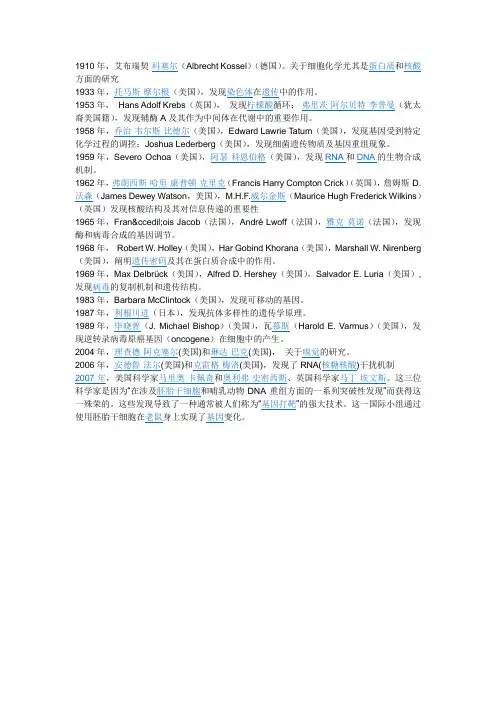
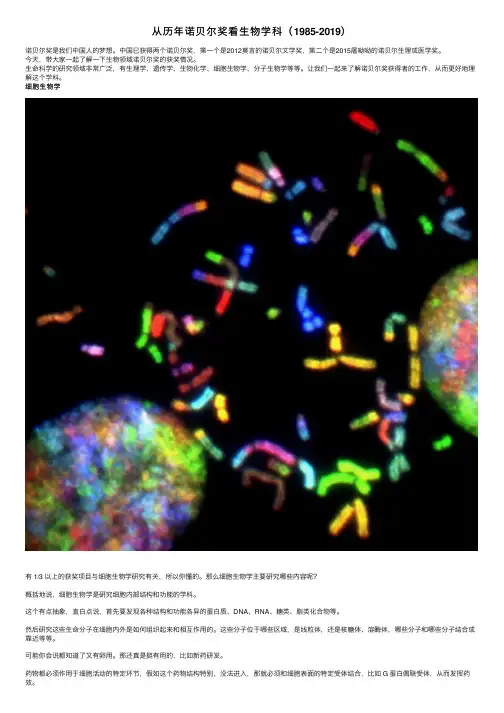
从历年诺贝尔奖看⽣物学科(1985-2019)诺贝尔奖是我们中国⼈的梦想。
中国已获得两个诺贝尔奖,第⼀个是2012莫⾔的诺贝尔⽂学奖,第⼆个是2015屠呦呦的诺贝尔⽣理或医学奖。
今天,带⼤家⼀起了解⼀下⽣物领域诺贝尔奖的获奖情况。
⽣命科学的研究领域⾮常⼴泛,有⽣理学、遗传学、⽣物化学、细胞⽣物学、分⼦⽣物学等等。
让我们⼀起来了解诺贝尔奖获得者的⼯作,从⽽更好地理解这个学科。
细胞⽣物学有 1/3 以上的获奖项⽬与细胞⽣物学研究有关,所以你懂的。
那么细胞⽣物学主要研究哪些内容呢?概括地说,细胞⽣物学是研究细胞内部结构和功能的学科。
这个有点抽象,直⽩点说,⾸先要发现各种结构和功能各异的蛋⽩质、DNA、RNA、糖类、脂类化合物等。
然后研究这些⽣命分⼦在细胞内外是如何组织起来和相互作⽤的。
这些分⼦位于哪些区域,是线粒体,还是核糖体、溶酶体,哪些分⼦和哪些分⼦结合或靠近等等。
可能你会说都知道了⼜有卵⽤。
那还真是挺有⽤的,⽐如新药研发。
药物都必须作⽤于细胞活动的特定环节,假如这个药物结构特别,没法进⼊,那就必须和细胞表⾯的特定受体结合,⽐如 G 蛋⽩偶联受体,从⽽发挥药效。
●诺奖获奖项⽬1985 年:在胆固醇代谢的调控⽅⾯的发现。
1986 年:发现⽣长因⼦。
1989 年:发现逆转录病毒致癌基因的细胞来源。
1991 年:发现细胞中单离⼦通道的功能。
1992 年:发现可逆的蛋⽩质磷酸化作⽤是⼀种⽣物调节机制。
1994 年:发现 G 蛋⽩及其在细胞中的信号转导作⽤。
1999 年:发现蛋⽩质具有内在信号以控制其在细胞内的传递和定位。
1998 年:发现在⼼⾎管系统中起信号分⼦作⽤的⼀氧化氮。
2001 年:发现细胞周期的关键调节因⼦。
2009 年:发现端粒和端粒酶如何保护染⾊体。
2012 年:发现成熟细胞可被重写成多功能细胞。
2013 年:发现细胞重要运输系统—囊泡传输系统的奥秘。
2016 年:细胞⾃噬研究。
神经⽣物学神经⽣物学是当今⽣命科学领域最具活性的学科之⼀,有⼈称之为 21 世纪的明星学科。
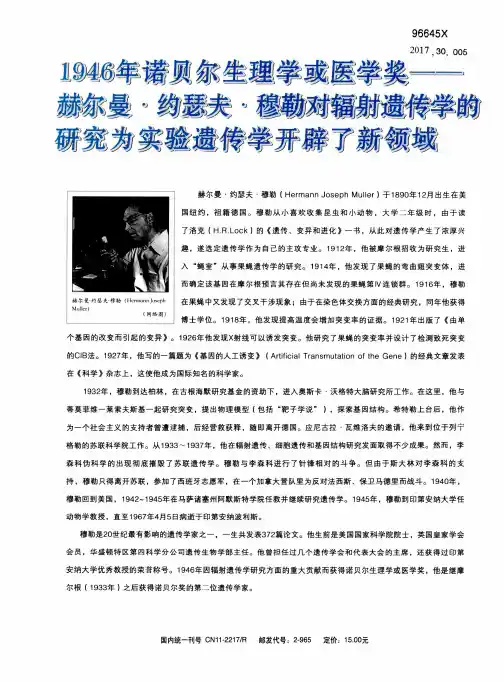
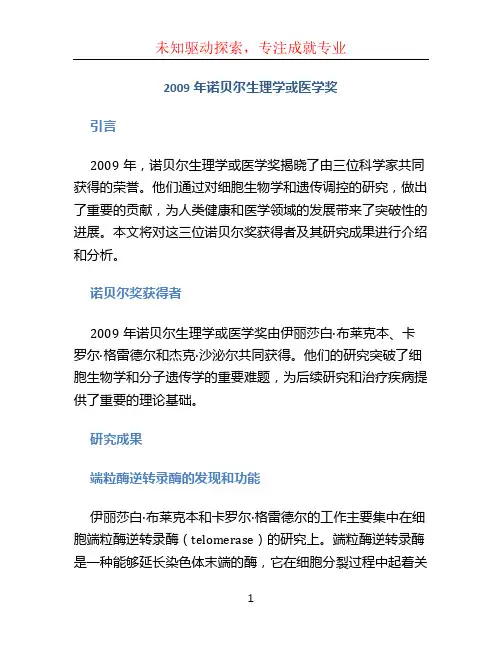
2009年诺贝尔生理学或医学奖引言2009年,诺贝尔生理学或医学奖揭晓了由三位科学家共同获得的荣誉。
他们通过对细胞生物学和遗传调控的研究,做出了重要的贡献,为人类健康和医学领域的发展带来了突破性的进展。
本文将对这三位诺贝尔奖获得者及其研究成果进行介绍和分析。
诺贝尔奖获得者2009年诺贝尔生理学或医学奖由伊丽莎白·布莱克本、卡罗尔·格雷德尔和杰克·沙泌尔共同获得。
他们的研究突破了细胞生物学和分子遗传学的重要难题,为后续研究和治疗疾病提供了重要的理论基础。
研究成果端粒酶逆转录酶的发现和功能伊丽莎白·布莱克本和卡罗尔·格雷德尔的工作主要集中在细胞端粒酶逆转录酶(telomerase)的研究上。
端粒酶逆转录酶是一种能够延长染色体末端的酶,它在细胞分裂过程中起着关键的作用。
在布莱克本和格雷德尔的研究中,他们发现了端粒酶逆转录酶的存在,并揭示了它与细胞衰老和癌症发展之间的关系。
通过对细胞中端粒酶逆转录酶的活性进行研究,布莱克本和格雷德尔发现了一种叫做“端粒”的结构。
端粒位于染色体末端,能够保护染色体免受损伤和衰老。
他们的发现为后续研究提供了重要的线索,帮助科学家们更好地理解染色体的稳定性和细胞衰老的机制。
RNA干扰的发现与应用杰克·沙泌尔的工作则集中在RNA干扰(RNA interference)的研究上。
RNA干扰是一种基因调控的机制,通过介导特定RNA分子的降解或抑制,来控制靶基因的表达。
沙泌尔的研究发现了一种叫做“小干扰RNA”的分子,它们能够干扰靶基因的转录或翻译过程。
这项发现不仅揭示了RNA干扰机制的存在,还为科学家们开辟了一条新的基因治疗途径。
利用小干扰RNA可以有效地靶向控制基因表达,为治疗疾病提供了新的思路和方法。
科学意义和应用前景这三位诺贝尔奖获得者的研究成果为细胞生物学和遗传调控领域带来了重大的突破,对生命科学的发展产生了深远影响。
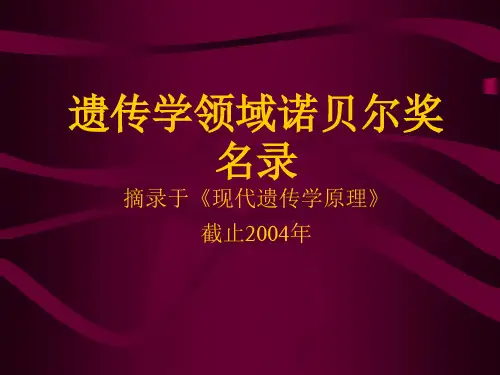
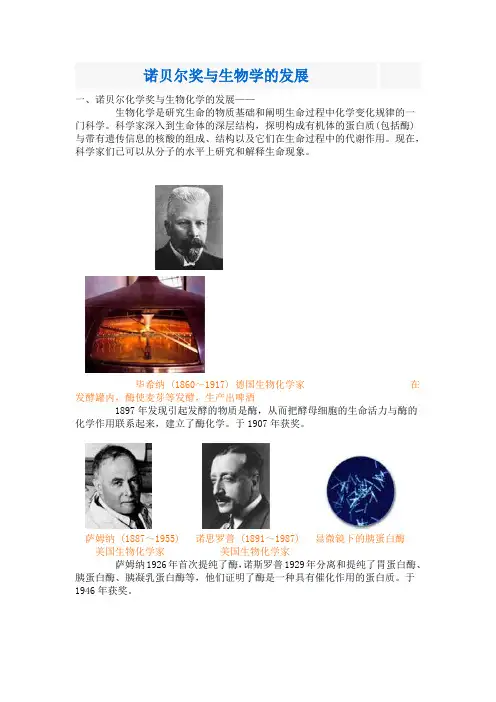
诺贝尔奖与生物学的发展一、诺贝尔化学奖与生物化学的发展——生物化学是研究生命的物质基础和阐明生命过程中化学变化规律的一门科学。
科学家深入到生命体的深层结构,探明构成有机体的蛋白质(包括酶)与带有遗传信息的核酸的组成、结构以及它们在生命过程中的代谢作用。
现在,科学家们已可以从分子的水平上研究和解释生命现象。
毕希纳 (1860~1917) 德国生物化学家在发酵罐内,酶使麦芽等发酵,生产出啤酒1897年发现引起发酵的物质是酶,从而把酵母细胞的生命活力与酶的化学作用联系起来,建立了酶化学。
于1907年获奖。
萨姆纳 (1887~1955) 诺思罗普 (1891~1987) 显微镜下的胰蛋白酶美国生物化学家美国生物化学家萨姆纳1926年首次提纯了酶,诺斯罗普1929年分离和提纯了胃蛋白酶、胰蛋白酶、胰凝乳蛋白酶等,他们证明了酶是一种具有催化作用的蛋白质。
于1946年获奖。
托德 (1907~1997) 酶是由数千个原子组成的非常复杂的化学物质。
英国生物化学家图为一个溶菌酶分子的模型。
首先发现并合成了核苷酸单体,证实其具有遗传特性,他还发现了核苷酸辅酶的结构。
于 1957 年获奖。
他的研究为揭开生命起源之谜开辟了道路。
康福思(1917~)澳大利亚裔英国化学家60年代证明酶是一种催化效能很高的生物催化剂,某一种酶只能对某一类化学反应起催化作用,于1975年获奖。
他为发展立体化学和阐明生物体内许多复杂的化学变化作出了重要贡献。
斯科 (1918~ ) 沃克 (1941~ ) 博耶(1918~ ) 丹麦生物化学家英国化学家美国生物化学家1957 年斯科发现了钠+、钾+-腺苷三磷酸酶; 1964至1981年博耶、沃克先后发现并阐明了腺苷三磷酸酶合成的基本酶学机制。
这一成果发现了人体细胞内负责贮藏和转输能量的“离子传输酶”,从而揭开生命过程中能量转换的奥秘。
三人于1997年获奖。
蛋白质是构成生物体的基本物质。
美国化学家鲍林40年代中期以图为电子显微镜下的蛋白质。

[键入文字]“遗传学之父”摩尔根简介摩尔根的成就有哪些?托马斯•亨特•摩尔根被世人尊称为“遗传学之父”。
他通过果蝇实验在遗传方面有了重大发现,并且因为他的研究成果极大的推动了人类社会的进步,于是在1933 年,摩尔根被授予诺贝尔奖。
那么,对于这位伟大的人物,你对摩尔根的故事又了解多少呢?1866 年9 月25 日,摩尔根在肯塔基州的列克星敦出生,摩尔根的伯父由于声望很高,所以摩尔根一家人很是受周围人的敬重,但是摩尔根很少提及他的这位名声响亮的伯父,他认为上辈人的成就和自己无关。
摩尔根从小便喜欢去捕捉小动物,像蝴蝶等,往家里带一些矿物或化石等等。
在他的家族中有过富商、军人、外交官、律师等各种人物,但却唯独没有科学家。
摩尔根算是他家族中的第一位科学家。
摩尔根的故事,在1886 年,在肯塔基州立学院,摩尔根获得了理学学士学位,但是在取得了这一学位后,摩尔根有些困惑,不知道去到社会后能做些什么,于是,他决定留在学校继续深造。
随后,他便去了霍普金斯大学的研究生院继续学习。
摩尔根是幸运的,因为霍普金斯大学学术自由,并且对生物学这一学科非常的重视,在这里,摩尔根可以大展拳脚,施展他的才华。
之后的岁月,摩尔根在遗传方面不断的突破,取得了巨大成就。
1945,摩尔根因病而与世长辞,人民为了纪念他做出的突出贡献,特意把基因之间的单位距离称为“摩尔根”。
从此,摩尔根以另一种方式留存于世。
只要学过生物学的人都会知道一个著名的人物,摩尔根。
摩尔根的全名是托马斯•亨特•摩尔根(Thomas Hunt Morgan) ,美国人,并且是举世闻名的进化生物学家,遗传学家和胚胎学家。
1933 年托马斯•亨特•摩尔根荣获诺贝尔生理学或医学奖。
那么摩尔根的成就究竟有什么呢?一生中摩尔根的成就最显著就是建立了遗传学的第三定律——连锁交换定律。
摩尔根一生都在进行胚胎学和遗传学研究,并且在孟德尔定律的理论前提下,创建了关于遗传学的“基因理论”。
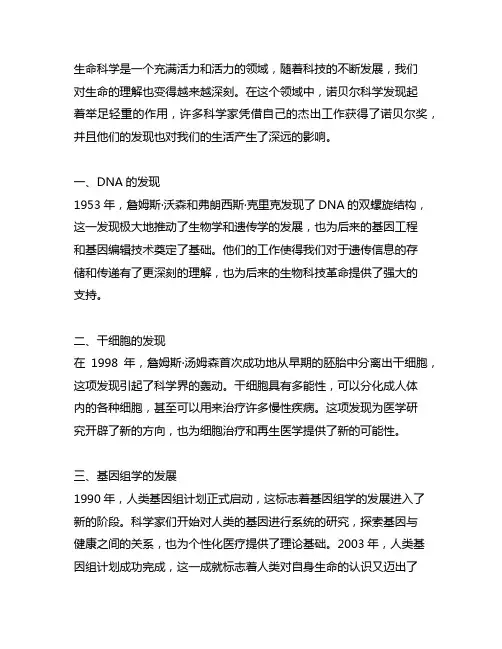
生命科学是一个充满活力和活力的领域,随着科技的不断发展,我们对生命的理解也变得越来越深刻。
在这个领域中,诺贝尔科学发现起着举足轻重的作用,许多科学家凭借自己的杰出工作获得了诺贝尔奖,并且他们的发现也对我们的生活产生了深远的影响。
一、DNA的发现1953年,詹姆斯·沃森和弗朗西斯·克里克发现了DNA的双螺旋结构,这一发现极大地推动了生物学和遗传学的发展,也为后来的基因工程和基因编辑技术奠定了基础。
他们的工作使得我们对于遗传信息的存储和传递有了更深刻的理解,也为后来的生物科技革命提供了强大的支持。
二、干细胞的发现在1998年,詹姆斯·汤姆森首次成功地从早期的胚胎中分离出干细胞,这项发现引起了科学界的轰动。
干细胞具有多能性,可以分化成人体内的各种细胞,甚至可以用来治疗许多慢性疾病。
这项发现为医学研究开辟了新的方向,也为细胞治疗和再生医学提供了新的可能性。
三、基因组学的发展1990年,人类基因组计划正式启动,这标志着基因组学的发展进入了新的阶段。
科学家们开始对人类的基因进行系统的研究,探索基因与健康之间的关系,也为个性化医疗提供了理论基础。
2003年,人类基因组计划成功完成,这一成就标志着人类对自身生命的认识又迈出了一大步。
四、RNA干涉技术的发现1998年,克雷格·梅洛和安德鲁·法尔博斯发现了RNA干涉技术,这项技术可以通过改变RNA的表达来控制基因表达。
这项发现不仅为基因的研究和治疗提供了新的途径,也为疾病的治疗和疾病基因的筛查提供了新的工具。
五、免疫疗法的突破2018年,詹姆斯·艾利森和托马斯·亨特分别因为他们对于癌症免疫疗法的开创性工作而获得诺贝尔奖。
免疫疗法通过激活人体自身的免疫系统来对抗癌症,不仅治疗效果显著,而且减轻了患者的副作用。
这一发现不仅为癌症的治疗带来了新的希望,也为免疫疗法的研究和发展提供了新的动力。
这些诺贝尔科学发现的背后,是无数科学家的辛勤努力和精湛技艺的结晶。
简报细胞新乐章,生命交响曲:Nature报道表观遗传学新发现生物谷>趋势>快讯生物谷推荐英文原文报道:N6-methyladenosine-dependent RNA structural switches regulate RNA-protein interactions日前,芝加哥大学的科学家们在Nature上发表最新的研究成果,揭示了N6-甲基腺苷(N6-methyladenosine,m6A)调控RNA-蛋白质相互作用的一个未知机制。
RNA结合蛋白通过与单链RNA结合基序(RNA binding motif,RBMs)1、2、3的结合来控制细胞的生物学进程。
而RBMs会被埋在RNA结构4、5、6、7内部,从而抑制了RNA-蛋白质的相互作用。
m6A是一种真核mRNA8-19的最为常见的内部修饰。
它涉及包括生物节律、减数分裂和干细胞发育在内的各种细胞功能的控制。
m6A能够选择性地被 YTH域家族蛋白2(human YTH domain family 2,YTHDF2)识别从而影响细胞质mRNA15的稳定性。
但是m6A是如何完成这些繁重的生理学作用还需要进一步探索。
本研究表明人类细胞m6A调控RNA结构依赖的RBMs进而影响RNA与蛋白的互作。
研究者将这种机制命名为"m6A开关"。
他们还发现m6A就近改变mRNA和长非编码RNA的结构来促进异构核糖核蛋白C 与其结合,HNRNPC是一中丰富的核RNA结合蛋白,负责pre-mRNA20-24的加工。
研究人员结合紫外交联合并免疫沉淀技术以及抗m6A免疫沉淀技术,使得我们能够识别HNRNPC结合区域的多达39060个m6A 开关。
球状的m6A的减少会降低HNRNPC与2798个高效m6A开关的结合。
并且发现受m6A调控的HNRNPC结合活性会进一步影响目标mRNAs的含量及其选择性地剪切,这表明m6A开关在基因表达和RNA成熟的调控作用。
细胞生物学1987年诺贝尔生理学或医学奖“抗体多样性的遗传学原理”获奖者:利根川进the genetic principle for generation ofantibody diversitySusumu TonegawaThe Nobel Prize in Physiology or Medicine 1987"for his discovery of the genetic principle for generation of antibody diversity"Massachusetts Institute of Technology (MIT)SummaryMan is surrounded by viruses, bacteria and other microorganisms which constitute a threat to life and health. When these contagious agents enter the body they are recognized and attacked by the immune defence. Important tools in the recognition of this large variety of intruders are the antibodies. They are produced by white blood cells called B lymphocytes. The parts of the microorganisms against which antibodies react are called antigens. The number of different antigens that the body may encounter is enormous. We are dealing with hundreds of millions of substances, all of them with their specific structure. Strangely enough our immune defense have at hand antibodies which can identify all these molecules and start to counter attack - that is, hundreds of millions of different antibodies which are ready in the body already in advance before they have seen the antigen against which they can react!This fabulous capacity to vary of antibodies is known since a couple of decades. The genetic background allowing this variation has, however, been an unsolved puzzle. The structure of the antibodies is determined by genes but as the human genome only contains about 100 000 genes it seemed unreasonable that they could allow the production of maybe a billion different antibodies.The man who explained this mystery is the Japanese Scientist Susumu Tonegawa. In a pioneering study published in 1976 Tonegawa could through a series of ingenious experiments show how parts of the genome of the cell (DNA) is redistributed under its differentiation from an embryonic cell to an antibody producing B lymphocyte. During the following two years Tonegawa completely dominated this area of research. He could in increasingly greater detail clarify how those parts of the genome which gives rise to antibody are moved around in order to allow each B lymphocyte to produce its own unique antibody. Tonegawas discoveries have increased our knowledge about structure of our immune defense. They also open up possibilities to increase the immune response against pathogenic microorganism through vaccination - and also to improve inhibition of unwanted immune reactions.The antibody, a molecule with many facesThe antibody is a protein where the building stones - amino acids normally form four chains. Two of these chains (polypeptides) are longand identical. The other two are short and are likewise identical. Together the four polypeptide chains form a Y-like symmetric molecule (Figure 1). Figure 1. A picture of an antibody molecule with two long (T) and two short (L) polypeptide chains which are kept together by sulphur bridges (-S-S). The variable parts of a long chain (V,D, and J) and a light chain (Y and J) together form the antigen binding area of the antibody.In man there are five different types of long chains which have been given letters M, D, G, A and E. The naming of the long chains forms the bases for the names of the five so called immunoglobulin classes: IgM, IgD, IgG and so on. The short chains are of two types: kappa or lambda. Each antibody molecule has - regardless of class - either two kappa or two lambda chains.Towards the base of the Y there is a constant part where the sequence of amino acids is the same in all antibodies belonging to the same class. In the outer ends of the two arms of the Y, however, there exist a significant variation in the amino acid sequence when comparing different antibodies. In this variable part there are three areas where variation is very large. These areas constitute the walls in a "pocket" where the foreign substance, the antigen, will fit and can bind. Y ou can make the analogy of an antibody molecule with a lobster where the claws of the lobster correspond to the antigen binding parts of the antibody.Through its Y-form the antibody accordingly is endow two identicalantigen binding areas. These areas have a more or less good fit to a particular antigen. The better the fit the harder to grip of the antigen and the more efficient the defense. As we are continuously confronted within an enormous variety of antigens we also have to have a large number of molecules there the variable parts do fit to different antigens.The constant part of the antibody does also contain important biological functions. After the binding of the antibody to an antigen on the surface on for example a virus (Figure 2) the antibody molecule is changed in such a way that its constant part will activate important parts of the immune defense. Among these is the complement system which can directly make holes in bacteria and other microorganism and which also attract white blood cells such as macrophages ("big eaters") and granulocytes to the battle ground.Figure 2. A polio virus particle is attacked by four IgG antibodies. Through this attack the infectious capacity of the virus is destroyed. It is mainly through this mechanism that polio vaccine is functioning.The richness of variety, an equation which didn't add upAntibodies are produced by a special kind of white blood cells which are called B lymphocytes and which in an adult human being amounts to one million million cells (1012). As a single B lymphocyte only can produce its own unique antibody the number of different antibodies in an individual can theoretically not exceed that of the number of Blymphocytes.The information how antibodies should be constructed lies in the genome of the B lymphocytes. One hypothesis suggested, that in this genome there exist one gene responsible for each type of polypeptide chain in the antibody. But here the problem was that the immune defense contains hundreds of thousands times more different antibody types than there are total number of genes in the B cells. The equation simply didn't add up and the hypothesis had to be abandoned. It was replaced by a second one which explained the almost limitless capacity of variation in antibodies as a result of some changes in the DNA of the B cell during the development of the individual.Susumu Tonegawa was the one who finally answered the question how the gene material in B cells could suffice to create the structures of a seemingly endless number of different antibodies. In 1976 he could in a convincing and elegant manner show how different immunoglobulin genes which were far apart in the embryonic cell in the B lymphocyte had been moved in closer contact. Under development from the germ cells (the sperm and egg cell) to an antibody producing B lymphocyte the genes forming the immunoglobulins had accordingly been redistributed. In subsequent experiment Tonegawa could clarify how different pieces of the genome were moved around, recombined and even could be "lost" to finally give rise to the DNA which is found in the mature B lymphocyte.In the human the genes for the long chains are present on chromosome 14, for the kappa chains on chromosome 2 and for the lambda chains on chromosome 22. Thanks to Tonegawa's pioneering work we now know how many immunoglobulin genes there are in man, how they are put together and how they can give rise to this high number of different antibodies.Figure 3. Redistribution of immunoglobulin genes for the long chain during the development from an embryonic cell (top) to an antibody producing B lymphocyte (bottom). Genes from each group V, D and J are brought together in the final form for functioning gene for the variable part of the long chain of an antibody molecule.Economy through wasteToday we know that three groups of genes participate in the creation of the variable part of the long chain, that is the part which together with the variable part of the short chain is specific for each antibody. These genes have the names V, D and J (Figure 3). The short chain has V and J genes. In man the number of different Y genes for the long chains are around 200 to which should be added about 20 D genes and 4 J genes. When the functioning gene of an antibody is to be created a single V, D and J gene are drawn at random from the three groups of genes. The process can be compared to a numbers lottery (Figure 4). 200 x 20 x 4 will give rise to 16 000 different variable parts.Figure 4. A registration sign for a car with its unique registration number produced through lottery can illustrate the process which leads to the creation of a unique antibody molecule. This registration number stands for Susumu Tonegawa, the 144th Nobel Laureate in Physiology or Medicine.V, D and J are put together in an irregular manner which will further enhance the richness of variation. And as the V and D genes often are different when inherited from our father and mother this will mean that already here possibility has been created for something like five million different forms of the variable part of the long chain. On top of this the light chain contributes with more than 10 000 variants. The final sum will be many billions possibilities of variation.We are accordingly well prepared for an encounter with any possible antigen. It is likely that normally only a minor part of the antibody variance will ever be put into usage. The immune system is extremely economic when using the DNA of the individual. At the same time a large number of lymphocytes are produced and only a few of these will ever have to participate in the immune defense of the body. The economy in the usage of DNA is thus combined with a seeming waste of cells. This is, however, necessary to maintain the high state of alertness which is required against possible new infections.The discoveries of Tonegawa explain the genetic background allowingthe enormous richness of variation amongst antibodies. Beyond deeper knowledge of the basic structure of the immune system these discoveries will have importance in improving immunological therapy of different kinds, such as for instance the enforcement of vaccinations and inhibition of reactions during transplantation. Another area of importance are those diseases where the immune defense of the individual now attack the bodies own tissues, the so called autoimmune diseases.翻译抗体多样性的遗传学原理1987年利根川进因“发现抗体多样性的遗传学原理”而获1987年诺贝尔生理学或医学奖麻省理工学院摘要人类周围环境中的病毒、细菌和其他微生物对人类的生命和健康构成威胁。
遗传学领域诺贝尔奖名录姓名国籍获奖时间功绩Morgan T.H. 美1933 发现连锁定律,奠定了遗传的染色体学说Muller H.J. 美1946 用X射线诱导突变Beadlr G.W. 美1958 建立“基因-酶”学说Tatum E.L. 美1958 建立“基因-酶”学说Ederberg J.L. Ochoa S..Kornberg A. 美美美195819591959建立细菌杂交的方法并发现转导发现多聚核苷磷酸化酶发现DNA聚合酶Watson J.D. 美1962 建立DNA的双螺旋模型Crick F.H.C. 英1962 建立DNA的双螺旋模型Wilkins M. 英1962 为双螺旋模型提供了DNA的X衍射图Jacob M. F. 法1965 提出乳糖操纵子模型Monod J. 法1965 提出乳糖操纵子模型Lwoff A. 法1965 揭示了溶原现象的本质Rous F.P. 美1966 发现鸟类中的致瘤病毒Holley R.W. 美1968 确定苯丙安酸tRNA的顺序、结构和反密码子Nirenberg M.W. 美1968 破译遗传密码Khorana H.G. 美1968 破译遗传密码Hershey A. 美1969 用噬菌体渗震实验证实DNA是遗传物质Elbruck M.D. 美1969 证实噬菌体的遗传重组Luria S. 美1969 论证噬菌体发生的突变Dulbecco R.D. 美1975 发现肿瘤病毒Temin H. 美1975 发现RNA病毒的反转录酶Baltimore D. 美1975 发现RNA病毒的反转录酶Arber W. 瑞士1978 提出限制与修饰,并发现Ⅰ类限制性酶Smith H. 美1978 转化Ⅱ类限制性酶并阐明其性质Nathans D. 美1978 制作酶切图谱Gilbert W. 美1978 建立化学法测序Sanger F. 英1980 建立“加”“减”法测序Berg P. 美1980 建立体外重组技术Benacerraf B. 美1980 发现细胞表面调节免疫反应的遗传决定结构Dausset J. 法1980 发现细胞表面调节免疫反应的遗传决定结构Snell G. 美1980 发现细胞表面调节免疫反应的遗传决定结构Klug A. 英1982 对核小体结构的研究Mcclintock B. 美1983 发现转座和转座因子Kohler G. 英1984 建立单克隆抗体制备技术Milstein C. 英1984 建立单克隆抗体制备技术Tonegawa S. 日1987 证明了免疫球蛋白的体细胞重组Varmus H.E. 美1989 发现鸟类肉瘤病毒中有致癌基因Bishop J.M. 美1989 发现鸟类肉瘤病毒中有致癌基因Cech T.R. 美1989 发现RNA的自体拼接Atman S. 美1989 发现RNA的自体拼接Mullis K. 美1993 建立PCR技术Smith M. 美1993 建立定点突变技术Sharp P.A. 加1993 发现断裂基因Roberts R.J. 美1993 发现断裂基因Gilman A. 美1994 发现细胞信息传递中的G蛋白Rodbell M. 美1994 发现细胞信息传递中的G蛋白Christine N-V. 德1995 研究了果蝇的早期发育Edward B.L. 美1995 研究了果蝇的早期发育W.Eric F. 美1995 研究了果蝇的早期发育Prusiner S.B. 美1997 朊蛋白构象的研究Boyer P.D. 美1997 三磷酸腺苷的形成过程Wolker J.E. 英1997 三磷酸腺苷的形成过程Furchgott R. F. 美1998 发现氧化氮在心血管系统中是作为一种信号分子Ignarro L.J. 美1998 发现氧化氮在心血管系统中是作为一种信号分子Murad F 美1998 发现氧化氮在心血管系统中是作为一种信号分子Blobel G 美1999 Blobel G和Bernhard Dobberstein 提出信号假说Harwell L 美2001 70年代初他发现了大量控制细胞周期的基因Nurse P 英2001 1990他发现了细胞周期蛋白依赖激酶(CDK) Hunter T 英2001 90年代初他发现了调节CDK功能的细胞周期蛋白。
基于诺贝尔奖情境的遗传学课程思政建设①朱慧贞,王萍,杨小芳,吴希恩,王鹏(定西职业技术学院,甘肃定西743099)一、诺贝尔奖的内涵及育人精神1895年,著名的瑞典化学家阿尔弗雷德·贝恩哈德·诺贝尔立下遗嘱,将他的遗产设立奖励基金,每年所得的利息作为奖金,颁发给在物理、化学、生理学或医学、文学及和平领域对世界有重大贡献的人。
诺贝尔物理学奖、化学奖、生理学或医学奖被称为自然科学领域的诺贝尔三大奖项。
高职学生政治思想观念比较薄弱,科学精神及人文素养普遍不足。
高职遗传学教学不仅要使学生掌握遗传学的基本知识,更重要的是让学生领悟科学精神。
科学精神体现着科学研究者的知识、思想、认知。
科学精神具体表现为实事求是、敢于质疑、包容开放、无私奉献、严谨求真、追求真理、批判创新、不断进取等。
科学精神的核心是求真、创新、奉献,其中求真是科学精神的基础,创新是科学精神的灵魂,奉献是科学精神的外在表现。
一份诺贝尔奖的获得就是一次完整的科学探索历程,基于真实的诺贝尔奖素材进行高职遗传学教学,是培养学生科学精神的良好途径。
与此同时,诺贝尔奖素材中的科学探究历程,是科学家协作共进、果敢无私、勇于奉献的真实写照,所以,诺贝尔奖也是传播人文精神的良好素材。
总之,诺贝尔奖是高职遗传学弘扬科学精神及人文精神的良好材料,对于当下高职学生有至关重要的德育意义。
二、诺贝尔奖融入高职课程的研究现状在“中国知网”官网以诺贝尔奖为主题进行搜索,与高等教育相关的文献共产生26篇,采用Citespace 文献可视化软件进分析,共现图谱如图1所示。
其中筛选出诺贝尔奖与高校思政建设相结合的文献共4篇,分别是基于诺贝尔奖案例的细胞生物学、有机合成化学、病原微生物学和医学等学科的思政建设,高职遗传学课程思政建设中融入诺贝尔奖案例的研究目前没有检索到相关文献。
图12022年以来诺贝尔奖融入高职课程思政研究现状的知识共现图谱三、诺贝尔奖融入遗传学课程思政的可行性本文挖掘高职遗传学中诺贝尔奖素材的育人元素,完善高职遗传学课程思政内容体系,对申顺先主编的《遗传学》第四版中有关诺贝尔奖的素材进行梳理,从与高职遗传学的关联内容、获奖人、获奖年限、获奖成就及学科思政教学目标几个方面进行归纳整理,完①基金项目:本文系2022—2024年度校本教科研项目“中职《遗传学》多元化情境教学的探索与实践”(课题立项号:LTNX [2022]011)的阶段性研究成果。